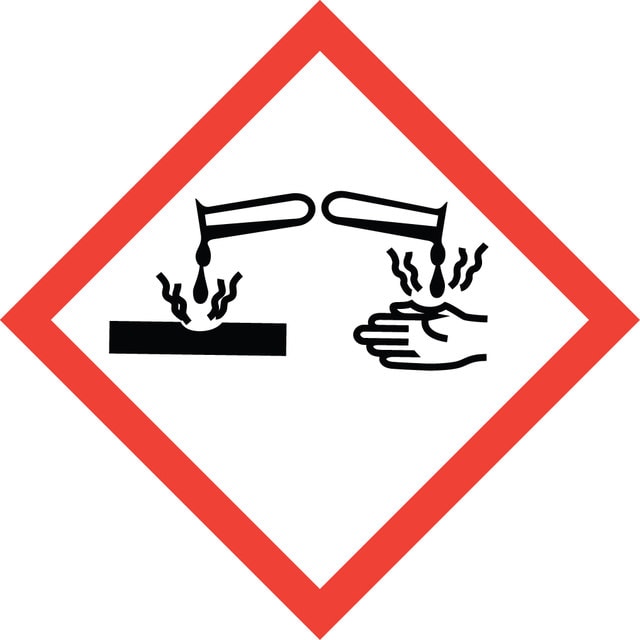328650
Potassium tert-butoxide solution
1.0 M in THF
Synonym(s):
Potassium tert-butylate, Potassium-2-methylpropan-2-olate solution
Select a Size
About This Item
form
liquid
Quality Level
reaction suitability
core: potassium
concentration
1.0 M in THF
density
0.902 g/mL at 25 °C
SMILES string
[K+].CC(C)(C)[O-]
InChI
1S/C4H9O.K/c1-4(2,3)5;/h1-3H3;/q-1;+1
InChI key
LPNYRYFBWFDTMA-UHFFFAOYSA-N
Looking for similar products? Visit Product Comparison Guide
Related Categories
General description
Application
- As a catalyst for the interesterification of rapeseed oil with methyl acetate.
- To promote Sommelet–Hauser rearrangements of N-benzylic amino acid-derived ammonium ylides under mild conditions.
- As a metal-organic precursor in the synthesis of KNbO3 ferroelectric films by the chemical vapor deposition method.
- To prepare 3-potassiooxamethylpyridine catalyst.
- As a strong alkoxide base reagent.
Signal Word
Danger
Hazard Statements
Precautionary Statements
Hazard Classifications
Acute Tox. 4 Oral - Carc. 2 - Eye Dam. 1 - Flam. Liq. 2 - Skin Corr. 1A - STOT SE 3
Target Organs
Central nervous system, Respiratory system
Supplementary Hazards
Storage Class Code
4.3 - Hazardous materials which set free flammable gases upon contact with water
WGK
WGK 1
Flash Point(F)
-2.2 °F - closed cup
Flash Point(C)
-19 °C - closed cup
Regulatory Information
Choose from one of the most recent versions:
Already Own This Product?
Find documentation for the products that you have recently purchased in the Document Library.
Which document(s) contains shelf-life or expiration date information for a given product?
If available for a given product, the recommended re-test date or the expiration date can be found on the Certificate of Analysis.
How do I get lot-specific information or a Certificate of Analysis?
The lot specific COA document can be found by entering the lot number above under the "Documents" section.
Does the Tetrahydrofuran used to make Product 328650, Potassium tert-butoxide solution, contain a stabilizer?
Yes, the THF contains about 0.025% butylated hydroxytoluene (BHT) as a stabilizer.
What gloves can I use to work with Product 328650, Potassium tert-butoxide solution?
We would recommend using Neoprene gloves such as Z402435, Z403407, Z402443, or Z402427.
How do I remove Product 328650, Potassium tert-butoxide solution, from the Sure-Seal bottle?
The Sure-Seal bottle has a septum held in place with a metal crimp cap. We would recommend removing the product by piercing the septum and withdrawing the liquid through a syringe to reduce the compound's exposure to air and moisture. We offer a line of non-coring syringe needles that are ideal for piercing septa.
How should Product 328650, Potassium tert-butoxide solution, be stored?
Room temperature storage is acceptable for this solution but we would recommend storing this product under nitrogen. The solution can decompose upon exposure to air or moisture. It also can absorb carbon dioxide from the air which will affect quality of the product.
What is the purity of Product 328650, Potassium tert-butoxide solution?
We do not perform overall purity testing on this solution. The product is prepared with reagent grade potassium tert-butoxide and then titrated with hydrochloric acid to define the concentration during the quality control analysis.
How do I find price and availability?
There are several ways to find pricing and availability for our products. Once you log onto our website, you will find the price and availability displayed on the product detail page. You can contact any of our Customer Sales and Service offices to receive a quote. USA customers: 1-800-325-3010 or view local office numbers.
What is the Department of Transportation shipping information for this product?
Transportation information can be found in Section 14 of the product's (M)SDS.To access the shipping information for this material, use the link on the product detail page for the product.
My question is not addressed here, how can I contact Technical Service for assistance?
Ask a Scientist here.
Articles
The properties of many devices are limited by the intrinsic properties of the materials that compose them.
Our team of scientists has experience in all areas of research including Life Science, Material Science, Chemical Synthesis, Chromatography, Analytical and many others.
Contact Technical Service


